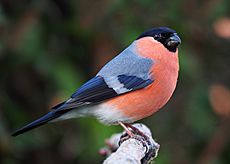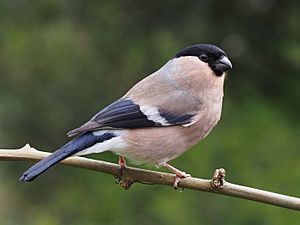Bullfinch facts for kids
Quick facts for kids Bullfinches |
|
|---|---|
 |
|
| Eurasian bullfinch, male | |
| Scientific classification | |
| Kingdom: | |
| Phylum: | |
| Class: | |
| Order: | |
| Family: | |
| Subfamily: | |
| Genus: |
Pyrrhula
|
Bullfinches are a group of small, colorful birds. They belong to the finch family, also known as Fringillidae. These birds are part of the genus Pyrrhula.
You can find bullfinches in many parts of the world. They live across a large area called the Palearctic region. This includes Europe, Asia, and parts of North Africa. Most species live in Asia, especially in the Himalayas. One species, the Eurasian bullfinch (P. pyrrhula), also lives in Europe.
The Azores bullfinch (P. murina) is a very rare type of bullfinch. It is an endangered species with only about 120 pairs left. These special birds live only on São Miguel Island in the Azores.
Contents
What Makes Bullfinches Special?
Bullfinches have some unique features that help you spot them.
Their Look: Colors and Beaks
All bullfinches have shiny black wings and tail feathers. They also have a bright white patch on their lower back, called a rump. Their legs and feet are a brownish-pink color.
Their beak is short and strong. It is perfect for eating buds and seeds. Most bullfinches have a black beak. But one species, P. nipalensis, has a yellowish beak.
Male bullfinches are often more colorful than females. They usually have a bright orange or red chest. Some types of bullfinches also have a black cap on their head.
How Bullfinches Evolved
Scientists have studied the DNA of bullfinches. They found that bullfinches are closely related to the pine grosbeak. The story of bullfinches began millions of years ago. It seems they first started to develop as a group in the Himalayan region.
Bullfinch Journeys: Migration
Many bullfinch groups move from one place to another during the year. This is called migration. Most of them travel short or medium distances. Birds from northern Europe tend to travel further than those from central Europe.
The number of migrating bullfinches changes each year. Scientists are still trying to understand why. Their autumn migration usually starts late, mostly in October and November. Spring migration happens between February and April.
Protecting Bullfinches: A Look at Populations
The number of Eurasian bullfinches in Britain has been decreasing. Since the mid-1970s, their population has dropped by 62%. This means there are fewer bullfinches around.
However, there's some good news. In recent years, more young bullfinches have been surviving. The number of nests that fail has also gone down. This suggests that efforts to protect them might be helping.


